
By T. J. Dunn, Jr., DVM
Everyone who has had a dog with a lick granuloma will tell the same story. The skin lesion started as a tiny sore spot on the skin and the dog kept licking at it. Applying medications didn't seem to help much and the darn thing kept spreading outward while thickening. It often would be wet and oozing from the dog licking and chewing incessantly at it. Finally a trip to the veterinarian revealed a name for this patch of thickened, scarred and irritated skin: ACRAL LICK GRANULOMA! "Well, OK", the owner would say, "so what do we do about it?"
The problem is that we veterinarians cannot give the owner a specific recipe for a cure for acral lick granuloma. The skin is so deeply affected that even down to the base layer of the skin there can be found under the microscope little pockets of bacteria, broken hair follicles, plugged and scarred oil glands and dilated and inflamed capillaries. And if these skin lesions are removed surgically, the dog simply licks at the sutures or incision line after the surgery heals, thus creating a brand new granuloma right where the original one was!
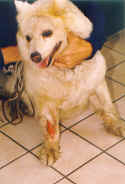
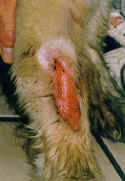
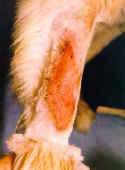
ac·ral adj. Of, relating to, or affecting peripheral parts, such as limbs, fingers, or ears
The photos above are of an Airedale with a classic case of acral lick granuloma. (Click on the photos to see a larger version in a new window.) The dog is perfectly healthy, is on an excellent diet, does not suffer from allergies but does have slight separation anxiety when his owner leaves for work.
In this case the "cause" of the licking specifically at the affected area of skin may be self stimulation to help allay the anxiety of separation from the owner. The skin lesions will heal slightly, almost seem like they are going to heal, and overnight (or during the day while left alone) the lick granuloma is activated, licked raw from continuous passes of the tongue.
Also with this dog, when one of the attempts to break the cycle of licking involved wrapping the lower leg with a cast to keep the dog away from the lesion, he began to make a new one in the same location on the opposite leg! Now there are TWO LICK GRANULOMAS!
This airedale isn't alone, however. No, there are certain breeds that appear to be more prone to acral lick granulomas, including the Doberman Pinscher, German Shepherd, Golden Retriever, Labrador Retriever, Irish Setter and Weimaraner.
There are numerous theories and one may apply for one dog and an entirely different theory may be correct for another. Take your pick:
1. Many dermatologists think that boredom is a major underlying factor in some cases of Acral Lick Granuloma. The dog's licking activity helps pass the time.
2. Some believe that allergic inhalant dermatitis creates stress in the skin resulting in inflammation and pruritus (itching) which triggers the dog's propensity to lick at any convenient area.
3. A foreign body such as a thistle spine, splinter or bee sting might start up a reaction in the skin which leads to drawing the dog's attention to the spot.
4. Bone or joint pain can draw the dog's attention to the wrist or ankle area and in an attempt to alleviate the discomfort the dog licks over the top of the joint.
5. Psychological stimuli such as separation anxiety, a new pet or child in the home, or neighbor dogs invading the dog's "territory" can create psychological stress. Self stimulation such as picking out an area to concentrate on and licking for extended periods of time are a way for the dog to relieve the "stress".
6. Hypothyroidism has played a role in some cases of acral lick granuloma, especially in Black Labs.
The use of laser surgical instrumentation is fast becoming a useful tool to assist in treatment of lick granulomas in dogs. The laser instrument ablates (removes) the tissue by vaporizing the surface layers. As the laser light energy passes over the diseased tissue it is essentially vaporized, nerve tissue is sealed so that little sensation is perceived by the patient, and bleeding from the surgical area is minimal.
Your veterinarian may have laser surgery or may refer you to a veterinarian who does so that a consultation specific for your dog's problem can be arranged.
There are also other numerous methods that have been tried in an effort to stimulate healing and resolution of acral lick granulomas in dogs. Some therapy is directed at attempts to keep the dog away from the skin lesion in order to allow it to heal. The truth is that no single method works very well.
Such things as bandaging the entire leg (the dog will lick just above any wrap or cast that is placed over the lesion) and applying nasty tasting materials such as bitter apple or hot sauce have been used to treat lick granulomas, usually to no avail.
Barbed wire wrapped in plaster casts doesn't work. Putting an Elizabethan collar on doesn't work well either because as soon as it is removed the licking starts again and the dog will activate the lesion all over again.
The bottom line is that these chronic, infected, ulcerated skin lesions are often the result of a psychological compulsion to lick and chew at this target area.
Obsessive and compulsive disorders do occur in dogs and these lick granulomas can therefore persist for years and years. Psychogenic and anti-anxiety drugs have been tried, too. And though they may make a slight difference, it dogs do not respond well enough to call psychoactive medications a cure.
Cortisone injections into and under the granuloma quiet them down, alleviate pruritus (itchiness) and shrink them --but only for a while. The dog will then start to lick at the area and the lesion becomes as big as ever. Deadening cutaneous nerves has been tried, even Cobra venom was professed to have a cure rate of 90 percent way back in the early 1970s, but these methods have proven to be unsatisfactory.
We've got a real dermatology nightmare here! Something makes the dog compulsively attracted to the granuloma and they often will start licking at a different place if the dog is prevented from licking at the original lesion!
So what is one to do about lick granulomas? Long-term antibiotics seem to be the best form of treatment -- as long as three to six months may be required for significant improvement. Cortisone topical creams rubbed into the lesion daily can help. Topical medications that have multiple antibiotic/cortisone ingredients can also help.
Acral lick granuloma is one disorder where the veterinarian preaches control or management of the skin problem since a cure is not now known. Any little thorn, splinter, tick bite, scratch or infection over the carpal areas in the front legs and over the area lower down from the tarsus in the rear legs can quickly lead to a granuloma. So keep a close eye on these problem spots and at the first sign of persistent licking at one particular site, get veterinary help as soon as possible.
Many types of dermatological problems are avoided if the dog or cat is consuming an optimum diet. If your dog or cat seems to lack good coat and skin health, consider upgrading the diet to a meat-based ingredient formula and adding a supplement, such as omega fatty acids, can make a very real difference.
Please remember not to be overcome with despair. You and your veterinarian will come to the best form of treatment for you furry friend.
 O Christmas Tree: Decorating for the Winter Holidays When You Have Pets
Winter holidays are especially exciting, with all
O Christmas Tree: Decorating for the Winter Holidays When You Have Pets
Winter holidays are especially exciting, with all
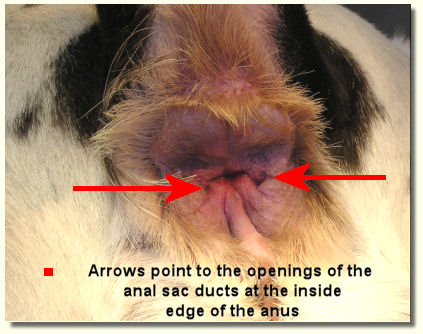 Anal Sacs Problems in Dogs (and Cats)
By T. J. Dunn, Jr., DVM
Few topics raise dog owner
Anal Sacs Problems in Dogs (and Cats)
By T. J. Dunn, Jr., DVM
Few topics raise dog owner
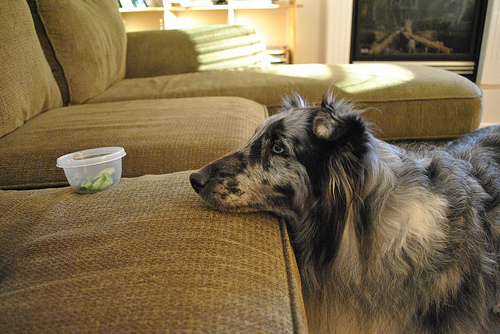 Weight Reducing Diets For Dogs (and Cats)
By T. J. Dunn, Jr., DVM
September 15, 2009
Weight Reducing Diets For Dogs (and Cats)
By T. J. Dunn, Jr., DVM
September 15, 2009
 Heartworm Disease in Dogs
Heartworms in Dogs
By T. J. Dunn, Jr., DVM
Heartworm Disease in Dogs
Heartworms in Dogs
By T. J. Dunn, Jr., DVM
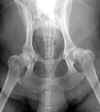 Arthritis: How to Recognize and Manage the Condition
By T. J. Dunn, Jr., DVM
Almost every
Arthritis: How to Recognize and Manage the Condition
By T. J. Dunn, Jr., DVM
Almost every
Copyright © 2005-2016 Pet Information All Rights Reserved
Contact us: www162date@outlook.com